Most people see a dandelion growing and immediately reach for the weed killer, but I am hoping to change a few minds on the usefulness of this “weed”. Dandelions are useful as an herbal remedy, detoxifier, and food source. The are full of vitamins, minerals, and healthy antioxidants.
Medicinal Use of Dandelion Roots
People have been using dandelion root as a detoxifier for the liver for many years, but recent research shows that it may have many more uses. Research published in the International Journal of Molecular Sciences shows that dandelion root is helpful in regulating blood sugar and insulin levels in diabetics. It works by controlling fats in the blood. Additional research at the University of Windsor found that it is useful in fighting a chemo-resistant melanoma and preventing the cancer cells from multiplying.
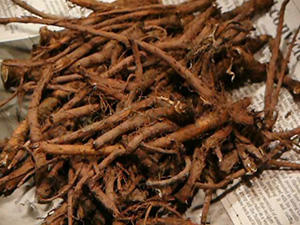
It has also been shown to calm inflammation, prevent urinary tract infections, reduce stomach upsets, and treat joint pain from arthritis and similar problems. Herbalists use it to treat infections, ease aching muscles, flush excess fluids from the body and as a detoxifier for the liver and gallbladder. With all of these medical benefits going for it, it seems such a waste to spray it with weed killer, doesn’t it? Instead, lets dig it up and make some use from the plant.
Related: How to Make Dandelion Bread (With Pictures)
Harvesting Dandelion Roots
Look for a clean source of dandelions such as a meadow or field away from traffic and human pesticide and herbicide use. Contaminated plants are not good for you or the environment. Let the plant grow through the summer and produce seeds for the next year. Harvest the roots in the fall after the weather has turned cooler. At this time, the insoluble fiber levels (inulin) are highest and the plant has the highest medicinal value.
You can also harvest in the early spring while the plant is still dormant. Spring roots are sweeter, less bitter, and easier to chew, if you harvest them before they bloom. Spring roots are useful for digestive ailments and stimulate more bile production.
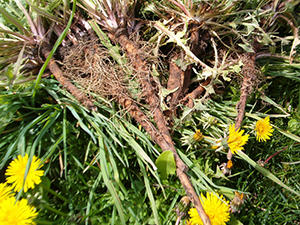
Ideally, you want to dig up the dandelion root whole with as little breakage as possible. The plant has a central tap root which has all the medicinal properties of the plant.
Dig deep with a dandelion digger, trowel, or garden fork. Loosen the soil around the plant and pull it up from the base.
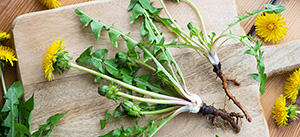
Wash the roots well to remove all dirt and slice them into pieces strips or slices for drying. Thin slices dry faster. I dry my dandelion roots on a dehydrator set to 95 F until they are completely dry and brittle.
Snap a few pieces in half and make sure they are dry all the way through. Alternately, dry them in a warm (but not hot) oven.
Store the dried roots in a cool, dry place for up to a year.
Related: How To Make Dandelion Honey Butter
Using Dandelion Root
For most medicinal uses, a decoction, infusion, or tincture is made to extract the medicinal compounds from the tough root. Go slowly when you first start using dandelion root, it is a diuretic. Start with one cup of dandelion root decoction daily, increasing it slowly if desired. Here are some general recipes to get you started:
Dandelion Root Decoction
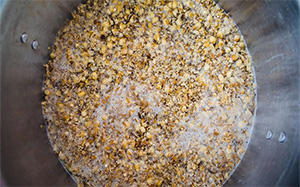 A decoction is an infusion made with water. It may be consumed as a tea but is often made stronger. To make a dandelion root decoction:
A decoction is an infusion made with water. It may be consumed as a tea but is often made stronger. To make a dandelion root decoction:
- 1 ounce dried dandelion root or 2 ounces fresh root, chopped
- 1 pint filtered or spring water
Place the chopped root pieces in a small pot with one pint of water. Bring it to a boil, reduce the heat to a simmer and cover the pot. Allow the decoction to simmer for 20 minutes. Strain the tea and enjoy.
Related: How To Make Survival Dandelion Jelly with 2 Years Shelf Life
Dandelion Root Tincture
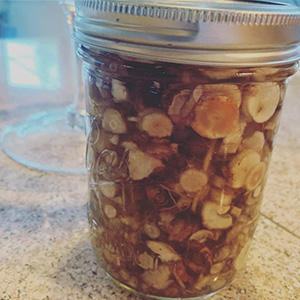 Because it is an alcohol extract, Dandelion Root Tincture retains some different extracts than the decoction. It can also be made ahead and stored for long periods so that it is always available. It is valuable for people who do not like the tea, since less is needed for the same effects
Because it is an alcohol extract, Dandelion Root Tincture retains some different extracts than the decoction. It can also be made ahead and stored for long periods so that it is always available. It is valuable for people who do not like the tea, since less is needed for the same effects
- 1 pint jar of dandelion root, chopped
- 1 pint of 80 proof or stronger vodka.
Fill the jar 3/4 full with dandelion root pieces and fill the jar with 80 proof vodka. Cover the jar with a tight fitting lid. Shake and tap the jar, removing all air bubbles. Steep the root for 4 to 6 weeks, shaking it daily. Keep the jar in a cool, dark place while steeping. After 4 to 6 weeks, strain out the root material and put the tincture in a dark glass bottle. Keep the tincture in a cool, dark place, tightly covered for 1 to 3 years. Use 10 to 15 drops of tincture daily, as needed.
Dandelion Flower Tea
Place 1/2 ounce of dried dandelion flower petals or 1 ounces of fresh petals in a tea ball and place in a cup of boiling water. Steep and enjoy warm or cold. Use Dandelion Flower Tea for weight loss, as a diuretic, a detox, or as a healthy beverage.
Dandelion Root Coffee
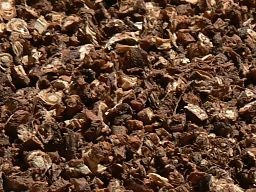
Dandelion Root Coffee is made with roasted dandelion roots that are ground like coffee and brewed. It is enjoyed like coffee and makes a good coffee substitute. Here is the recipe:
Chop dried dandelion roots into small pieces and spread onto a roasting pan or cookie sheet.
Roast the dried root in a 200 F oven for approximately 4 hours, stirring and turning occasionally. The roots should be completely browned.
Cool the roasted roots and grind them in a coffee grinder. Brew like coffee, or steep 1 teaspoon of ground in a cup of boiling water for 10 minutes. Strain and enjoy.
Store the roasted roots in an airtight container and grind fresh for best flavor.
Precautions
The dandelion plant is edible and considered safe for most people. Some people may be allergic to dandelion and should not use it. It can also interact with some medications, including diuretics, lithium, and Cipro. It is always best to consult your doctor before using any herbal product if you are taking prescription medications or have a health condition.
You may also like:
 The 10 Best Prepper Foods You Can Find At Costco
The 10 Best Prepper Foods You Can Find At Costco
Davy Crockett’s “Make It and Forget It” Food Of the Wild Frontier (Video)
Shocking Foods That People Ate During the Leningrad Siege

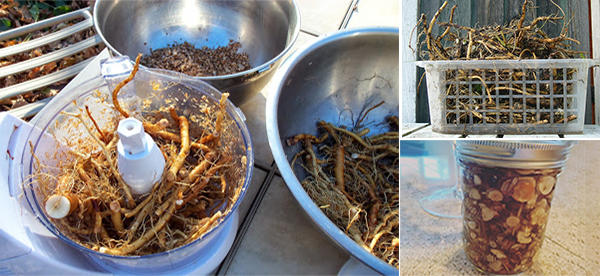




















A local grocery store sells various herbal teas, including dandelion tea. I had read about dandelion tea on various sites and decided to give it a try. As I mentioned in a comment on a previous article about dandelion, it tasted quite earthy. Now I don’t know if the company preparing the dandelion tea knows what they are doing or not. I suppose they do. However, based on my experience with that tea, dandelion tea is low on my list of must have preparation supplies.
Okay, we are starving because our red leaf lettuce crop has been wiped out by a herd of desert tortoises. Then dandelion leaves and roots will be considered as an alternative source.
I love that video they had on the news of the herd of desert tortoises stampeding at Yellowstone and one of them damaging the rented SUV.
There are good human and animal studies showing dandelion helping in the treatment of Type2 diabetes, but the best treatment is to cut way back on carbs, lose weight, and exercise. But most of my friends and family who have Type2 don’t want to change and just chuckle about it, “I’m having a extra slice of chocolate swirl N.Y. cheesecake but I’ll just take some Insulin to make it okay…”
The early greens like dandelion, mustard, and docks could be the difference between life and death for people starving through the winter. I don’t poison dandelions, but I ain’t about to drink no chickory coffee either.
Following a SHTF event, if you are a person who can’t get through a day without coffee to get their brain and body going, a 50-59 blend of dried dandelion root (also known as chicory) and properly roasted coffee beans will satisfy your body’s need for the coffee’s caffeine. Drinking a blend of ground coffee beans and chicory worked very well during the Civil War, and is still embraced as a cultural element of native or long term residents of New Orleans. Blending ground roasted coffee beans and chicory was also a widespread practice during The Great Depression and the Dust Bowl years as well as during World War II rationing.
Perhaps more importantly following a SHTF event, using a 50-50 blend of dried dandelion root coffee beans will make your stockpiled supply of precious coffee beans last twice as long, compared to only using coffee beans. While the dried, roasted dandelion root won’t add to the caffeine content in your cup of coffee, making your supply of roasted coffee beans last twice as long will prevent, or at least delay, the unpleasant physical and psychological withdrawl symptoms your body will experience when you no longer have a source of the drug caffeine. Those people will not be pleasant to be around when they run out of roasted coffee beans in their stockpile and can’t find any roasted or unroasted coffee beans anywhere for which to barter for other supplies or marketable services they may have.
Old Indiana: Thank you for your post. Upon reading your post I immediately went on line to read about chicory. Heretofore I only knew that folks in New Orleans added it to coffee because for some reason they had grown up with it.
I found that while chicory is related to dandelion, it is not really a dandelion. It is called blue dandelion because it typically has blue flowers as opposed to yellow. It can also have white or pale pink flowers. It can grow to as tall as 40 inches whereas most dandelions that I am familiar with don’t grow nearly as tall. Chicory more resembles the plant that some call cat’s paw, but which here locally is called hog weed. In other parts of the country, hog weed is a totally different plant from cat’s paw.
Chicory originally, according to the articles I read, came from Europe where it is used in coffee drinks in several countries and especially in a couple of regions.
It also is, apparently, excellent forage for ruminants. It has been cultivated in New Zealand specifically for that purpose. It is said to inhibit the grown of intestinal parasites in ruminants and some unverified studies seem to confirm that.
Although it is apparently not native to the Western Hemisphere, it now grows from Canada to the Mexican border.
You are correct that it was used as a coffee extender during the Great Depression in this country and during WWII, especially in Europe. I have read of ersatz coffee in reading novels and other accounts of WWII in Europe and most of them comment unfavorably on ersatz coffee. Perhaps ersatz coffee was something different from chicory coffee.
Your post moved me to explore a topic I had only casually had reference to. Thank you for posting it.
The lettuce is safe. They’ll eat the dandelion first.
@ Old Indiana Farmboy: NO, dandelion root is NOT the same as chicory root. They are two different plants!
Both are used as substitutes for coffee, but they are different.
I like to use a blend of both dandelion and chicory root, roasted. I add in dandelion leaf as an extra beneficial ingredient.
Your idea to stretch your coffee by doing a 50/50 blend is a nice idea.
This is the sad story of mankind. God has given all the herbs for man’s health, and the fallen mankind has, for the greater part ignored or demeaned these to his own hurt. This is the similar to many ignoring God’s way to save mankind as in John 3:16.
Thank you for posting this. I have heard of my family using this but no one remembers how or what they used it for. So thank you for sharing.
I would love to order . Lost book of remedys, but the shipping is so high I really cant afford it , I am on a fixed income, thank you for all the information in tour newsletters
Hi Birdwomen,
Thank you so much for your interest in The Lost Book of Remedies.
Please check your Inbox. I have just sent you an email.
God bless,
Claude
I just watched on video by chrisbeatcancer
he mentions that dandelion tea is anti-cancer…. might be worth having around.
If we’re going to talk about cancer…how many of you eat apricot seeds daily as a preventative? For those of you who don’t know what I’m talking about, these seeds as well as some other seeds contain amygdalin which has been given the nickname B-17. This is the same thing as Laetrile…a supposed cancer killer according to the Homeopathic people. US medicine will tell you it is a terrible poison which means it probably has some cancer treating benefits. One thing for sure…it IS NOT a vitamin and don’t let anyone tell you otherwise. It can kill you if you eat to many at once but so can half the other things good for us. I eat 6-8 seeds throughout the day.
Spike: Spike: Apricot seeds also contain small amounts of cyanide. Cyanide pills were what the Nazi brass carried toward the end of the war in case they were captured.
Cyanide pills have been given to various undercover agents to spare them from “enhanced interrogation methods” if captured.
From the CDC website:
What cyanide is
• Cyanide is a rapidly acting, potentially deadly chemical that can exist in various forms.
• Cyanide can be a colorless gas, such as hydrogen cyanide (HCN) or cyanogen chloride (CNCl), or a crystal form such as sodium cyanide (NaCN) or potassium cyanide (KCN).
• Cyanide sometimes is described as having a “bitter almond” smell, but it does not always give off an odor, and not everyone can detect this odor.
• Cyanide is also known by the military designations AC (for hydrogen cyanide) and CK (for cyanogen chloride).
Where cyanide is found and how it is used
• Cyanide is released from natural substances in some foods and in certain plants such as cassava, lima beans and almonds. Pits and seeds of common fruits, such as apricots, apples, and peaches, may have substantial amounts of chemicals which are metabolized to cyanide. The edible parts of these plants contain much lower amounts of these chemicals.
• Cyanide is contained in cigarette smoke and the combustion products of synthetic materials such as plastics. Combustion products are substances given off when things burn.
• In manufacturing, cyanide is used to make paper, textiles, and plastics. It is present in the chemicals used to develop photographs. Cyanide salts are used in metallurgy for electroplating, metal cleaning, and removing gold from its ore. Cyanide gas is used to exterminate pests and vermin in ships and buildings.
• If accidentally swallowed, chemicals found in acetonitrile-based products that are used to remove artificial nails can produce cyanide when metabolized by the body.
• Hydrogen cyanide, under the name Zyklon B, was used as a genocidal agent by the Germans in World War II.
• Reports have indicated that during the Iran-Iraq War in the 1980s, hydrogen cyanide gas may have been used along with other chemical agents against the inhabitants of the Kurdish city of Halabja in northern Iraq.
How you could be exposed to cyanide
• You could be exposed to cyanide by breathing air, drinking water, eating food, or touching soil that contains cyanide.
• Cyanide enters water, soil, or air as a result of both natural processes and industrial activities. When present in air, it is usually in the form of gaseous hydrogen cyanide.
• Smoking cigarettes is probably one of the major sources of cyanide exposure for people who do not work in cyanide-related industries.
How cyanide works
• The extent of poisoning caused by cyanide depends on the amount of cyanide a person is exposed to, the route of exposure, and the length of time that a person is exposed.
• Breathing cyanide gas causes the most harm, but swallowing cyanide can be toxic as well.
• Cyanide gas is most dangerous in enclosed places where the gas will be trapped.
• Cyanide gas evaporates and disperses quickly in open spaces, making it less harmful outdoors.
• Cyanide gas is less dense than air; so it will rise.
• Cyanide prevents the cells of the body from using oxygen. When this happens, the cells die.
• Cyanide is more harmful to the heart and brain than to other organs because the heart and brain use a lot of oxygen.
Immediate signs and symptoms of exposure to cyanide
• People exposed to a small amount of cyanide by breathing it, absorbing it through their skin, or eating foods that contain it may have some or all of the following signs and symptoms within minutes:
◦ Dizziness
◦ Headache
◦ Nausea and vomiting
◦ Rapid breathing
◦ Rapid heart rate
◦ Restlessness
◦ Weakness
• Exposure to a large amount of cyanide by any route may cause these other health effects as well:
◦ Convulsions
◦ Loss of consciousness
◦ Low blood pressure
◦ Lung injury
◦ Respiratory failure leading to death
◦ Slow heart rate
• Showing these signs and symptoms does not necessarily mean that a person has been exposed to cyanide.
Long-term health effects of exposure to cyanide
Survivors of serious cyanide poisoning may develop heart, brain and nerve damage.
Chuck…actually to my understanding, Amygdalin is converted to Cyanide once it is in your body. The Homeopaths say that it effects only the cancer cells while US medicine says it effects all your cells. I’ve read up on the Web countless hours on this topic and both sides seem to not give on their point of view. I personally know of one man that was diagnosed with Stage IV prostate cancer and cured himself with nothing more than apricot seeds and oxygenating his blood(he said. I wonder if he was confused with Ozoning his blood). These practices(blood Ozone) are not only done in Mexico cheaply but done in the US and Germany for much more money.
Cyanide is why taking to many apricot seeds at once can kill. A little is good but a lot is bad. I personally know 2 people who almost died from drinking to much water over the course of several hours.
IMHO….When it comes to cancer treatment in the USA ,a little is good and a lot is bad…I’m referring to conservative/natural approach vs. Chemo/radiation. It also just so happens to run parallel to cost of treatment.
Spike: Having been down the prostate cancer road eight years ago, my preference was robotic surgery. I am not totally happy with the results, but am cancer free eight years post-op and apparently still alive. I feel my choice in physicians was fortunate. He spent a lot of time explaining in detail all the options of which he was aware to me. I also found a couple on internet searches that had way too few participants and too short a time span for me to even consider.
I also know that the palliative effect is 30%. So if you believe strongly enough that drinking 2 quarts of V-8 juice and smoking 5 joints of Maui gold a day will cure you, you have a 30% chance of being right. The mind is a very powerful, little understood organ. I didn’t think my belief in botox injections into the prostate, nor cryogenics was strong enough to warrant utilizing either of those unproven procedures.
If we are unfortunate enough to have to make decisions about the big C, the best we can do is seek out understanding medical advice, read as much as we can, ask lots of questions, choose a course of treatment that you have confidence in and hit the ball from where it lies.
A very close friend of my daughter was diagnosed with breast cancer at a young age. She went through eight years of hellish treatment. If there was a treatment, she underwent it. She enrolled in study treatments. She took all the conventional treatments. In my view, it was hell. And, unfortunately, none of them ultimately helped. Personally, I think after the first couple of courses of treatment didn’t work I would have eaten my gun but each of us must make that individual decision for ourselves and there is no right or wrong answer. Whatever the decision, f it is your uninfluenced decision, it is the right answer for you alone in my view.
I researched the two articles in the International Journal of Molecular Sciences. The are listed below:
Dandelion Root Extract Induces Intracellular Ca2+ Increases in HEK293 Cells
Hypolipidemic and Antioxidant Effects of Dandelion (Taraxacum officinale) Root and Leaf on Cholesterol-Fed Rabbits
I am not sure what conclusion to draw from from a Ca2 increase in HEK293 cells. I read the annoted article but the net effect of increased Ca2 in HEK203 cells eluded me. I guess it is back to Bonehead Molecular Biology 101 again.
As far as the effect of dandelion products on cholesterol munching bunnies I couldn’t get enough of the extract to display so that I could draw any kind of conclusion as to how that related to humans.
The third reference to the University of Windsor, that was too vague to follow up. Another mystery “study” done with no indication of any peer review. At least the IJMS indicates that their published articles are peer reviewed.
If the end of the world has not occurred and we still have standard medicine and if a doctor who is qualified tells you that you have cancer, please do not ignore conventional treatment. If you must use some anecdotal herbal medicine, be sure to advise your doctor that you are self-administering tincture of dandelion root so that when you turn into a gopher, at least he or she will have a clue why your front incisors are growing at an interesting rate and your fingernails have become long and pointy.
All joking aside, knowing the historical uses of plants can be extremely important after the world ends and there are no other medications available. Until that time, realize that medical doctors are only humans. They can’t perform miracles the best they can do is the best they can do. Yes, avoid the money grubbers who can’t spend 15 minutes talking to you about your condition and what you can expect and treatment alternatives. If you must go the herbal routine, keep your treating doctor advised.
Sometimes, despite the best efforts of a sincere, motivated, dedicated medical professional, the results of treatment are not favorable. As the hippies used to say, “shit happens.” Good people die and sob’s seem to go on forever like the energizer bunny.
How I wish. It’s too hot here for it. I can baby chicory along, but have yet to see it go to seed. niio
Other lesser known more potent detoxifier is Cilantro. very few cannot stand the taste, so for them dandelion salad mmm. Yes I love dandelion salad. i Like, OLE!
Hot bacon dressing! But, no dandy-lions here, too hot. ‘Sides, when cows get a taste, they fight over them. I do have some chicory, but it stalls out when it gets too warm. cilantro is a winter crop, and what is left in the garden goes to seed for corianders. A deep taproot puts humus in the soil, too. I tried epazote (natural beano) but the weather was too weird this year and it failed. niio
Thumbs up for mentioning Epazote… mouthwatering, love it on tacos, fresh beans in broth from scract off the pot, on quesadillas…
ok side tracked. had to look into your comment being winter crop. here’s what google came up with. Is Cilantro an annual or perennial?
The herb is called “cilantro” when grown for its leaves and “coriander” when grown for its spicy seeds. Though cilantro is an annual plant, it may be mistaken for a perennial in frost-free climates because it self-seeds prolifically. Anyway, loved your comment. i Like, OLE!
Ole! Some cilantro is planted in September, if days are cool enough. I plant in November and harvest a few leaves till it begins to send up shoots. Whole above ground plant goes in freezer bags. Those left to seed will die off when done. How do you grow epazote? I sew it and ants and birds eat it. Or it gets windy and kills the tops. niio
i go by FVP. OLE! is my trademark LOL
you did tell me you’re full blooded American Indian when I asked you if you’re cuban because they like to say Ño which your niio phonetically sounds like.
I plant epazote by transferring the plant. I set it and forget about it. whenever I use seeds, I start them off indoors by using egg cartons then outside. never had problems with ants, maybe because I throw my used coffee grounds on them. Epazote is used to treat Malaria.
trademark time:
i Like, OLE!
My family is so mixed we should just call ourselves American. Most of it is Native American (injun), tho, ani Susos Kanona, People of the Moon of Maize confederacy, AKA Susquehanna River, Penna. The ancestors never thought of skin as race. Niio is an Iroquois contraction word, walk in God’s beauty. I have a pile (knee deep) of coffee grounds waiting for cool temps in October to use as mulch. Ants march right over it. Cornmeal, corn flour, sugar and borax (3-1) mixed as a last solution. Corn flour is cheap and usually works fast. Borax, too much, is toxic to the soil. Word is, today, malaria is treated in S. America with zinc, which ‘blows up’ viruses. After we got my stepfather to use it, he never had another bout (caught it in Korea). niio!
With regard to cilantro, it does have a genetic oddity that to some, it tastes like soap. I happen to be one of the fortunate people that absolutely LOVE it. But others, as you mention, can’t stand it. There are a few herbs that act like that, where some love them and some can’t stand it. It is genetic.
Lets not forget good ‘ol Charcoal, I make my own activated charcoal.
FVP, how do you make activated charcoal? And, do you make your own charcoal? If so, how do you do that? Thank you from an old woman learning new tricks.
That’s a very guarded secret passed for generations can’t tell you…
Thank You for you interest. Great for food poisoning. same thing they administer at a hospital for food poisoning.
Do Not Use Kingsford Charcoal since it has lighter fluid in it.
go buy a 2×4 pine or any wood will do at the local hardware store. yes you can use the kind they sell on corners that say freshly cut fire wood bundle for $5.00
I say that because someone is going to be a smarty pants. scrap wood from the hardware for free. if you have a woodstove use that to burn it.
I have a small Hobo oven that I made from a big can. I use it to make smores with my daughter and keep the charcoal. Hobo oven instructions on youtube
You can use the fireplace. pretty sure you’ve been left with black burnt pieces of wood that didn’t turn to ashes. that’s your charcoal and it’s activated. activated means it’s oxygenated.
1. wood, burn it. light it with paper or cardboard.
2. let it burn till becomes charcoal.
3. put it in a sealed jar. that’s it.
4. once you have those burnt pieces of wood, to re-oxygenate simply put it in and oven and cook them for 2.5 hours at 350 degrees. I like to reactivate / re-oxygenate when making a new batch. to reactivate or not Meh.
You can also burn tortillas on the stove with fire. I gave that to my children when they had upset stomach, diarrhea.
How do you take it is the next question huh ?
You can crush them into powder and drink it like that
( they do sell it like that. I don’t like it)
or encapsulate them. (they do sell it like that at Whole Foods for $14 ? Rite Aid has some but they’re caplets and are coated pink. I don’t like.
I break a piece and swallow it with water.
How big a piece ? depends on how big you can swallow. don’t go to big because it’s very dry even with water. I just take it raw size.
That’s it? People make it out to be such a big deal, and that’s all it is? Thank you. From the bottom of my heart, thank you for clarifying that. I know my great-grandparents had beautiful teeth and no dentist’s care, unless it was a cavity. They would chew sweet brush twigs after each meal, then chew a piece of charcoal about the size of the end of my thumb. Their teeth turned gray, but it was rare they had any problems. And, if their food wasn’t sweet enough, they added sugar by the cup. Even sweet corn and tomato sauce had sugar added. Grandparents lost some teeth, and then all their teeth because chewing charcoal was hick, not hip. Same with the parents, who had dentists, toothbrushes and commercial toothpaste. One sister made regular visits to a dentist and today has a beautiful smile. It’s like the stars, it comes out at night. I usually managed to avoid dentists and still have most of mine. Again, thank you!
You’re welcome. My 12 yr old daughter brushes her teeth with charcoal, her choice. I also keep some stuffed socks with charcoal to take away odors in a room, car and in my sneakers. Now for the Big Deal that others make it to be is if you’re going to make it for sale as in pharmaceutical grade, it’s a big process and big machinery involved for pressure and “purity”. I can cook eggs, but once a lady said to me “have you ever done eggs for 1000 people?” ah nope, “move over” LOL I learned a thing or two that day. she cooked for 3000 people that day at a convention. My Hat Off to people with that type of experience…
Thank you FVP, for your well-described instructions, and for caring enough to put in everything I would need to know but didn’t think to ask. May you be blessed for helping me..
Your’e Welcome.
i Like, OLE!
I am looking for about your product place lave me a message. When I post this, I am looking for more information on this I’m looking for more information on in the books there any more information you have can help me out or where I can find the book please get back to me soon as possible appreciate it thank you have a nice day and be
I have used activated charcoal many times when I have eaten something going bad. It works! That’s why I keep it on hand at all times and carry it when I travel.
I take it at the very first sign that I’ve eaten something I shouldn’t have, if it wasn’t cooked thoroughly, if it was just going off, for whatever reason.
Welcome home! niio
googled translated to english. This is not appropriate, take your spam out of here. anyone if free to copy and paste at google translator. sending moderator copy and have you blocked
I actually like to blend both roasted root and leaf and add in equal amounts, roasted chicory root to round out herbal “coffee”.
I find it makes a better cup for flavor.